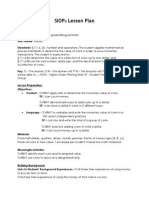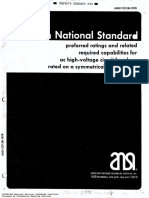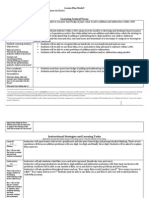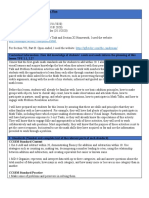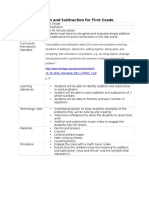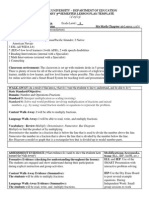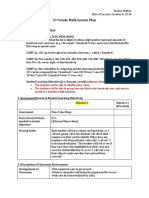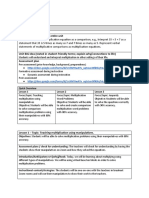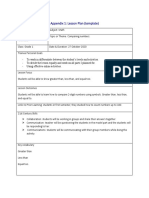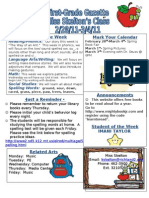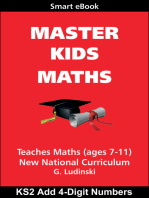Math Lesson 1 2nd Grade
Math Lesson 1 2nd Grade
Uploaded by
api-247228121Copyright:
Available Formats
Math Lesson 1 2nd Grade
Math Lesson 1 2nd Grade
Uploaded by
api-247228121Original Title
Copyright
Available Formats
Share this document
Did you find this document useful?
Is this content inappropriate?
Copyright:
Available Formats
Math Lesson 1 2nd Grade
Math Lesson 1 2nd Grade
Uploaded by
api-247228121Copyright:
Available Formats
DIXIE STATE UNIVERSITY DEPARTMENT OF EDUCATION ELEMENTARY 4th SEMESTER & STUDENT TEACHING LESSON PLAN TEMPLATE (1/25/13)
) Teacher Candidate Leslie Vasquez-Hunt Grade Level 2nd Grade Title Take a Survey CONTEXTUAL FACTORS (classroom factors)
Contextual Factors: 8 students 5 girls, 3 boys 3 Hispanic, 5 Caucasian Vision: Student #1 wears glasses Left-handed: Student #2 Reading: Red: Student #5, Student #6 Yellow: Student #7 Green: Student #1, Student #2, Student #3, Student #4, Student #8 ELL: Student #4 and Student #5 (Both students speak English fluently). Student #5 is within Intensive reading level due to comprehension, fluency is on level. Other contextual factors: Student #5 and Student #6 need Tier 2 instruction throughout most lessons due to comprehension skills. Student #8 is a high level learner and needs enrichment. Student #3 has a hard time sitting still and needs opportunities to move around and joke with his peers or he shuts down. Student #7 is very sensitive, yet honest with her feelings. She will tell you she does not understand, and at times will be hard on herself and cry. Student #5 does not like a lot of noise or distractions when he is trying to focus. When this happens he shuts down and will become the student who will tell on other students. Student #1 needs glasses; she has a tendency to forget them at home and will need to sit close to the board to see. She also loses focus easily and needs to be pushed to stay on task. She will also say she is done with an assignment in order to talk to peers. Student #6 will rush through assignments to get them done. She says she understands but her work proves otherwise. Classroom environment: The classroom is set up in tables with groups of 4-5 students at each table. The class is broken up from grade 2 and grade 3 during math instruction. The classroom has 8 computers set up in the back of the room. The classroom has 10 iPads for student use. The classroom has a whiteboard that has the ability to be used as a Smartboard. There is an Image Mate (Elmo) to use for overhead purposes, DVD and VHS player as well. The classroom has access to the Internet and a teacher computer. There are vocabulary and other language material all over the classroom. Students have a shelf at the end of their tables with school supplies, and cubbies by the front door for backpacks and coats.
WALK-AWAY (As a result of this lesson, what do I want the students to know, understand, and be able to do?)
State Standard/Objective: Domain: Measurement and Data Work with Time and Money Standard 2.MD.10. Draw a picture graph and a bar graph (with single-unit scale) to represent a data set with up to four categories. Solve simple put-together, take-apart, and compare problems using information presented in a bar graph. (SIOP 3-Content appropriate)
Content Walk-Away: I will read and speak in order to take a survey and organize data using tally marks. (SIOP 1&2 language and content objectives) (SIOP 3 content appropriate) Language Walk-Away: I will read and speak in order to take a survey and organize data using tally marks. (SIOP 1&2 language and content objectives) (SIOP 3 content appropriate) Vocabulary: Data Survey Tally Marks
ASSESSMENT EVIDENCE (What evidence do I need to show the students
have learned the Walk-Away?) Formative Evidence (checking for understanding throughout the lesson): Think/Pair/Share: There will be the following problem on the board: Ten pet owners named the kind of pet they own. The tally chart showed eight tally marks next to Dog and four tally marks next to Cat. Students will create the tally chart. If ten people were surveyed, how can the tally chart be correct? I will have students tell their answer to a friend before sharing with the whole class. Homework: Students will be given homework from Chapter 9 Lesson 1 out of their student workbooks. Content Walk-Away Evidence (Summative): Students will be able to read, write, and speak in order to organize data using tally marks. Language Walk-Away Evidence (Summative): Students will be able to read, write, and speak in order to organize data using tally marks.
Modifications/Accomod ations (ELL, IEP, GATE, etc.) All students should be able to understand this without modifications. For Student #8 I will ask him to write a real world story problem using tally marks for his peers to solve.
Approx. Time
ACTIVE LEARNING PLAN
Activate/Building Background Knowledge Introduce new vocabulary I will write the data, survey and tally marks on the board. I will ask students what they know about these words. I will ask when they have seen tally marks and what they are used for? I will then explain that to take a survey is another way to ask a question. Additionally, a survey involves asking questions, and then recording the answers. The responses to those questions can be recorded by tally marks. The information, or data, is usually displayed in a chart. I will also display the vocabulary cards associated with these words and post them on the white board next to the objective and vocabulary words. Essential Question: How do tally marks help you to organize data? How can you organize data using tally marks? Why would you need to organize data? When is it important to collect data? Review: Common Core Quick Check (This is to assess student learning from Chapter 8 Lesson 5). (SIOP 4-Supplementary materials, 5-Adaptation of content, 6-Meaningful activities, 7-Linked to background, 8-Linked to past learning, 9-Key vocabulary)
Formative assessment: Learning Goal I will be able to understand new vocabulary, and concepts learned from lesson 1.
Success Criteria Define new vocabulary and learn concepts from lesson 1.
Assessment Strategy Ask questions, probe for deeper understanding. Model Quick Check responses on Common Core Quick Check
Modification/accommodations: (ELL, IEP, GATE, etc.) I will organize my students into two groups with 3 and 4 students in each group. I will assign a term to each group. I will have students look up the term in the glossary. They will be given chart paper to write the definition, and draw a visual math example with the term labeled. One member from each group will then share their definitions using the sentence: Our math work is _______. It means _____. I will then post the charts in the classroom on the math word wall. Focus Lesson (I do it) I will introduce to the students how to take, read, and write surveys using tally marks. I will discuss with the students that they are going to take a survey. Students are going to ask their classmates a question and keep track of their responses by using tally marks. Model: I will draw one tally mark and a set of five tally marks on the board as I explain what numbers represent. (Connect to background knowledge: Remember when we learned to count on? Do you remember how to count by fives? We learned this when we counted money and nickels.) Then, I will draw seven tally marks on the board and show students how to count the tally marks to find the total. Next, I will draw nine tally marks on the board. We will count by five, then count on by ones. What number do these tally marks represent? 9 I will then have student #5 read the directions at the bottom of the student page 529. I will then tell the students that when I will ask you what your favorite fruit, the choices will be apples, oranges, and grapes, so think about which one you like best. I am going to model. I am going to have you raise your hand when I say a fruit. Then, I will use tally marks to represent how many students like the fruit choice being asked. I will then take the survey. As I ask the students I will use tally marks on the white board to represent their responses. Once the survey is complete we will count the tally marks and circle the fruit that is most liked and place a square around the fruit that is least liked. Hands on: As I am taking the survey I will have students use their work mat to write tally marks when I am writing my tally marks. They will circle the most fruits liked and place a square around the least fruit liked. Model together: I will guide students through the example survey we just conducted. I will discuss the vocabulary terms and their meanings. I will talk about writing and interpreting tally marks and the diagonal slash to show five. I will then write tally marks on the board for the number 16. Is there an easy way to count this? Remember we can skip count by 5s, and then count one more. The answer is? 16 (SIOP 10-Appropriate speech, 11-Clear explanation, 12-Variety of techniques, 13-Students use learning strategies, 14-Scaffolding, 15-Higher-order thinking, 16-Opportunity for interaction, 17Grouping supports objectives, 18-Wait time, 19-Opportunity for L1 students, 20-Hands-on materials, 21-Activities to apply content/language knowledge, 22-Language skills: reading, writing, listening, speaking) Formative Assessment: Learning Goal I will be able to speak and write tally marks in order to take a survey and read the data.
Success Criteria Read, write and interpret data.
Assessment Strategy Ask questions for deeper understanding Model
Modification/accommodations: Additional tally marks will be written on the board for students who are not able to count the tally marks. I will ask students to write on their write boards 10, 13, and 18 using tally marks to make sure they understand how they are reading and writing tally marks to take surveys. Guided Instruction (We do it) See and Show: I will guide students through the example at the top of See and Show page 530. We will read the definitions of survey, tally marks and data to review. We will work problems 1 and 2 together as a class. As a class we will take another survey and then answer the questions. This survey is about which season do you like best? We will answer question 1 (Which season is liked best?) For question 2 I will guide students to write a number sentence to solve the question (How many students like winter and fall all together?). (SIOP 10-Appropriate speech, 11-Clear explanation, 12-Variety of techniques, 13-Students use learning strategies, 14-Scaffolding, 15-Higher-order thinking, 16-Opportunity for interaction, 17Grouping supports objectives, 18-Wait time, 19-Opportunity for L1 students) Formative Assessment: Learning Goal Success Criteria Assessment Strategy I will be able to take a survey Read, write and interpret data Work together questions 1-2 and answer questions by using using tally marks. Look for evidence by walking tally marks. around and seeing their work.
Modification/accommodations: I will have each student go to the board one by one and make a tally mark. I will ask the 5th student to make a diagonal slash through the previous 4 tally marks. I will have students work with a partner to find the total number of tally marks. Collaborative/Cooperative (You do it together) I will have students work collaboratively to take a survey and answer the questions needed for problems 3-5. They will then be able to work with their table buddies to answer the problem solving questions. I will then walk around and help students with any questions they may have. Formative Assessment: Learning Goal Success Criteria Assessment Strategy I will be able to take a survey Read, write and interpret data Look for evidence by walking and answer questions by using using tally marks. around and spot-checking tally marks. students working together.
Modification/accommodations: For students #5 and #6 I will guide them through the exercises in On My Own. I will help them use manipulatives while working through the exercises. Independent (You do it alone) Students will be asked to do the Homework section independently in class or take it home for homework. (SIOP 23-Content objective supported, 24-Language objective supported, 25-Students engaged, 26Pacing) Summative Assessment: Summative Assessment will be the homework that will be due the following morning. Modification/accommodations: Student #8 will be allowed create a survey question and create his own tally chart to record the data. Then I will have him present the survey to the class and conduct the survey to answer the question.
Closure/Review of walk-aways, vocabulary, and essential questions (Note: Closure includes student interactions, reflection, and/or demonstrations.) We will review the objective for the day and discuss what we learned this would also include vocabulary. I will also conduct a Think-Pair-Share and write the following problem on the board: Ten pet owners named the kind of pet they own. The tally chart showed eight tally marks next to Dog and four tally marks next to Cat. I will then have students create a tally chart. If ten people were surveyed, how can the tally chart be correct? I will have students share with a buddy before they share the answer with me. Students will talk then share with me as they walk out the door for recess. (SIOP 27-Review vocabulary, 28-Review concepts, 29-Feedback, 30-Assessment) SIOP Indicators (Add SIOP number and description within the lesson plan) Preparation: 1-Content objectives, 2-Language objectives, 3-Content appropriate, 4-Supplementary materials, 5Adaptation of content, 6-Meaningful activities Building Background: 7-Linked to background, 8-Linked to past learning, 9-Key vocabulary Comprehensive Input: 10-Appropriate speech, 11-Clear explanation, 12-Variety of techniques Strategies: 13-Students use learning strategies, 14-Scaffolding, 15-Higher-order thinking, Interaction: 16-Opportunity for interaction, 17-Grouping supports objectives, 18-Wait time, 19-Opportunity for L1 students Practice/Application: 20-Hands-on materials, 21-Activities to apply content/language knowledge, 22-Language skills: reading, writing, listening, speaking Lesson Delivery: 23-Content objective supported, 24-Language objective supported, 25-Students engaged, 26Pacing Review/Assessment: 27-Review vocabulary, 28-Review concepts, 29-Feedback, 30-Assessment
TEACHING NOTES
What do I need to remember to do? I need to remember to list my objective on the board, and ask the deeper level thinking questions. I also need to remember to give appropriate feedback. What materials do I need to have ready? I need to have PowerPoint ready for the lesson. What is the approximate time needed for this lesson? The appropriate time needed for this lesson is 45 minutes.
REFLECTION AFTER LESSON
How can I use the assessment data to reflect on & evaluate the outcomes of teaching and learning? I can use the assessment data to reflect on the students learning outcomes. This way I will be able to evaluate how my lesson will be for the following day. I will need to know if I need to reteach some of the content or if I will be able to move forward without reteaching and just a review. How can I transfer what I learned from teaching this lesson to future teaching? I can transfer what I have learned about group configurations in this class to other lessons, or if I need to add more enrichment or slow down. What was effective and not effective? Modeling tally marks and connecting to skip counting by 5s was very effective in my teaching. This was even beneficial for my lower level learners. What goals can I set to improve my practice and student learning? My goals are to be able to have all my students understand and interpret data by using tally marks without forgetting to use the diagonal slash mark to keep track of their results. This lesson was very successful and students were enjoying the survey portion of the assignments. They were connected to their learning and engaged the whole time. Students enjoyed the group configurations and the ability to talk and share their answers with each other.
You might also like
- 2nd Grade Math Siop Lesson PlanDocument4 pages2nd Grade Math Siop Lesson Planapi-260642936100% (5)
- Math Siop Lesson PlanDocument3 pagesMath Siop Lesson Planapi-35496503350% (2)
- Habitats Siop LessonDocument6 pagesHabitats Siop Lessonapi-268179861100% (1)
- Ansi C37.06-1979Document34 pagesAnsi C37.06-1979Jamila A. Smith100% (1)
- 3 Edtpa Lesson Plan January 2016 NewestDocument4 pages3 Edtpa Lesson Plan January 2016 Newestapi-304981674100% (1)
- Butterfly SiopDocument4 pagesButterfly Siopapi-201991174100% (2)
- Siop Lesson PlanDocument4 pagesSiop Lesson Planapi-273729585100% (1)
- 1 Siop Lesson Plan 1-3Document3 pages1 Siop Lesson Plan 1-3api-282820736100% (1)
- Siop Lesson Edited For WeeblyDocument7 pagesSiop Lesson Edited For Weeblyapi-315469741No ratings yet
- Lesson Plan 2 Base Ten BlocksDocument6 pagesLesson Plan 2 Base Ten Blocksapi-253732673100% (1)
- Lesson Plan 2Document4 pagesLesson Plan 2api-284370520No ratings yet
- Siop Lesson Plan 1Document6 pagesSiop Lesson Plan 1api-522660932No ratings yet
- Te 331 Math Lesson CinerDocument16 pagesTe 331 Math Lesson Cinerapi-494433412No ratings yet
- 2nd Grade Lesson PlanDocument2 pages2nd Grade Lesson Planapi-425503895No ratings yet
- Ted 410 Math LessonDocument9 pagesTed 410 Math Lessonapi-486956371No ratings yet
- Teacher Work SampleDocument28 pagesTeacher Work Sampleapi-437973397No ratings yet
- l2 Writing CapstoneDocument16 pagesl2 Writing Capstoneapi-369325039No ratings yet
- Addition and Subtraction For First Grade Lesson Plan With Rubic 1Document3 pagesAddition and Subtraction For First Grade Lesson Plan With Rubic 1api-335965936No ratings yet
- Edc286-M7a1 Siop Lesson PlanDocument5 pagesEdc286-M7a1 Siop Lesson Planapi-357645737No ratings yet
- Name of System - LGSF With Fiber Cement Board On Both Sides Using Glass Wool InsulationDocument7 pagesName of System - LGSF With Fiber Cement Board On Both Sides Using Glass Wool InsulationNishan GajurelNo ratings yet
- Unit Plan Math Lesson 3 of 6Document4 pagesUnit Plan Math Lesson 3 of 6api-193663371No ratings yet
- Final and Complete Teacher Work SampleDocument58 pagesFinal and Complete Teacher Work Sampleapi-241263607No ratings yet
- Siop Lesson PlanDocument4 pagesSiop Lesson Planapi-354980593No ratings yet
- Siop Lesson PlanDocument5 pagesSiop Lesson Planapi-317325489No ratings yet
- Concordia University Nebraska Education Department Lesson Plan FormatDocument2 pagesConcordia University Nebraska Education Department Lesson Plan FormatSamantha EllisNo ratings yet
- Siop Lesson PlanDocument4 pagesSiop Lesson Planapi-522747312No ratings yet
- Siop Lesson Plan With ReflectionDocument6 pagesSiop Lesson Plan With Reflectionapi-315708883100% (2)
- Life Cycle of A PlantDocument4 pagesLife Cycle of A Plantapi-232234414No ratings yet
- Math Lesson Plan 2Document12 pagesMath Lesson Plan 2api-456889650No ratings yet
- Example Lesson PlansDocument15 pagesExample Lesson Plansapi-289863780No ratings yet
- 2nd Grade Math Lesson Plan 3-Digits PDFDocument7 pages2nd Grade Math Lesson Plan 3-Digits PDFapi-430893986No ratings yet
- Four Seasons Lesson PlanDocument5 pagesFour Seasons Lesson Planapi-300153360100% (1)
- UAB's SIOP Lesson Plan: Standards Objectives Alabama COS Content Objective(s) : Academic AchievementDocument5 pagesUAB's SIOP Lesson Plan: Standards Objectives Alabama COS Content Objective(s) : Academic Achievementapi-291444126100% (1)
- SIOP Lesson Plan - WeatherDocument9 pagesSIOP Lesson Plan - WeatherKennan100% (2)
- ELD Levels/can Do Descriptors, Etc.) : This Lesson Is Intended For Use in A 9th Grade ELADocument18 pagesELD Levels/can Do Descriptors, Etc.) : This Lesson Is Intended For Use in A 9th Grade ELADanahNo ratings yet
- Unit Lesson Plan: Standards That Bridge The Entire UnitDocument5 pagesUnit Lesson Plan: Standards That Bridge The Entire UnitKalinda HarrisNo ratings yet
- Edtpa Lesson PlansDocument12 pagesEdtpa Lesson Plansapi-34049548767% (3)
- Third Grade Lesson Plan MultiplicationDocument4 pagesThird Grade Lesson Plan MultiplicationkimNo ratings yet
- Second Lesson OpinionDocument5 pagesSecond Lesson Opinionapi-450830120No ratings yet
- Lesson Plan - Ruby Bridges SS Grade 3Document4 pagesLesson Plan - Ruby Bridges SS Grade 3MelissaNo ratings yet
- Lesson Plan Greater Than Less Than 2Document5 pagesLesson Plan Greater Than Less Than 2bashaer abdul azizNo ratings yet
- Lesson Plan #2Document6 pagesLesson Plan #2Jason DonaldsonNo ratings yet
- 1st Grade Voting Lesson PlanDocument4 pages1st Grade Voting Lesson Planapi-339178917No ratings yet
- Newsletter Feb.28 - March 4Document1 pageNewsletter Feb.28 - March 4KeighleyNo ratings yet
- Siop - Science Lesson Plan 5th GradeDocument4 pagesSiop - Science Lesson Plan 5th GradeReginald JacksonNo ratings yet
- Ahora No Bernardo David McKeeDocument9 pagesAhora No Bernardo David McKeeLuz Mery LopezNo ratings yet
- Lesson Plan 2nd GradeDocument4 pagesLesson Plan 2nd Gradeapi-426934978100% (1)
- SIOP Lesson PlanDocument4 pagesSIOP Lesson PlanPayton BallNo ratings yet
- Seasons Lesson PlanDocument6 pagesSeasons Lesson Planapi-364942122100% (1)
- Lesson Plan Template: GCU College of EducationDocument15 pagesLesson Plan Template: GCU College of EducationBrittanyNo ratings yet
- Math Lesson First Grade-Telling TimeDocument11 pagesMath Lesson First Grade-Telling Timeapi-433319406No ratings yet
- Math Lesson PlanDocument11 pagesMath Lesson Planapi-3142478620% (1)
- Corduroy Read AloudDocument4 pagesCorduroy Read Aloudapi-283833776100% (1)
- Lesson PlanDocument4 pagesLesson Planapi-512136633No ratings yet
- Lesson Plan 1 - CommunitiesDocument18 pagesLesson Plan 1 - Communitiesapi-380707221No ratings yet
- Reflection For Math Lesson 30-40Document1 pageReflection For Math Lesson 30-40api-336072959100% (1)
- Module 5 - Lesson Plan Story ElementsDocument6 pagesModule 5 - Lesson Plan Story Elementsapi-289506791No ratings yet
- Ps g1 Wwasummativerubric 1516Document2 pagesPs g1 Wwasummativerubric 1516api-292158599No ratings yet
- Differentiated Lesson Plan Written ExpressionDocument5 pagesDifferentiated Lesson Plan Written Expressionapi-597970375No ratings yet
- Mapping the Way from Teacher Preparation to edTPA® Completion: A Guide for Secondary Education CandidatesFrom EverandMapping the Way from Teacher Preparation to edTPA® Completion: A Guide for Secondary Education CandidatesNo ratings yet
- Classroom-Ready Resources for Student-Centered Learning: Basic Teaching Strategies for Fostering Student Ownership, Agency, and Engagement in K–6 ClassroomsFrom EverandClassroom-Ready Resources for Student-Centered Learning: Basic Teaching Strategies for Fostering Student Ownership, Agency, and Engagement in K–6 ClassroomsNo ratings yet
- Leslie I. Vasquez-Hunt: Professional ProfileDocument2 pagesLeslie I. Vasquez-Hunt: Professional Profileapi-247228121No ratings yet
- 5th Grade Essential Standard PosterDocument1 page5th Grade Essential Standard Posterapi-247228121No ratings yet
- Chapter 9Document2 pagesChapter 9api-247228121No ratings yet
- Standard VI Reference ListDocument1 pageStandard VI Reference Listapi-247228121No ratings yet
- Observation BackDocument1 pageObservation Backapi-247228121No ratings yet
- DemographicsDocument17 pagesDemographicsapi-247228121No ratings yet
- Praxis Score 1Document1 pagePraxis Score 1api-247228121No ratings yet
- Eled 4440 Final EportDocument17 pagesEled 4440 Final Eportapi-247228121No ratings yet
- 3550 Unit Plan BucknerDocument4 pages3550 Unit Plan Bucknerapi-247228121No ratings yet
- Student Notebook 2Document10 pagesStudent Notebook 2api-247228121No ratings yet
- 3900 Differentiated Lesson PlanDocument7 pages3900 Differentiated Lesson Planapi-247228121No ratings yet
- Plantation Rate Analysis-R1Document3 pagesPlantation Rate Analysis-R1anandrishikesh24No ratings yet
- Fibre GlassDocument7 pagesFibre GlassFirly Rajabi SoeratinoyoNo ratings yet
- Ielts Solved Graphs Tips PDFDocument10 pagesIelts Solved Graphs Tips PDFmithu11100% (1)
- Removable Partial Denture Design A Need To Focus On Hygienic PrinciplesDocument9 pagesRemovable Partial Denture Design A Need To Focus On Hygienic Principleslian liaanNo ratings yet
- Egorov ArtemDocument38 pagesEgorov ArtemAndrei MartinasNo ratings yet
- Kilrain 1113 EssayDocument5 pagesKilrain 1113 Essayapi-409530890No ratings yet
- Swot Rationale For A Semester SystemDocument6 pagesSwot Rationale For A Semester Systemkharemix0% (1)
- Deontological EthicsDocument4 pagesDeontological EthicsNEET ncert readingNo ratings yet
- Engl-309 Files 2013 01 ConsultingProposalRequirementsDocument2 pagesEngl-309 Files 2013 01 ConsultingProposalRequirementsRajib ChowdhuryNo ratings yet
- CLUPDocument2 pagesCLUPjedsNo ratings yet
- UTeachEngineering Summative Evaluation ReportDocument67 pagesUTeachEngineering Summative Evaluation ReportTony PetrosinoNo ratings yet
- DEF Value Chain AnalysisDocument5 pagesDEF Value Chain AnalysisMusa LarbiroNo ratings yet
- General Notes and Specifications For Structural Works (Issued As A Supplement To The Structural Plans)Document12 pagesGeneral Notes and Specifications For Structural Works (Issued As A Supplement To The Structural Plans)Brian SantosNo ratings yet
- (DAO 2000-55) Rules and Regulations Governing The Implementation of The Revised Price Monitoring System For Forest ProductsDocument13 pages(DAO 2000-55) Rules and Regulations Governing The Implementation of The Revised Price Monitoring System For Forest ProductsKerwin Leonida0% (2)
- Geng, Hwaiyu (2004), Manufacturing Engineering Handbook - QFDDocument6 pagesGeng, Hwaiyu (2004), Manufacturing Engineering Handbook - QFDCristina ZavalaNo ratings yet
- Fundations LessonsDocument3 pagesFundations Lessonsapi-634427929No ratings yet
- OOSE - Week 6 - Class DiagramDocument23 pagesOOSE - Week 6 - Class DiagramInnoxentDollNo ratings yet
- Masai School x Mood IndigoDocument26 pagesMasai School x Mood Indigoamol.kalraNo ratings yet
- The Early National PeriodDocument20 pagesThe Early National PeriodEunice GarridoNo ratings yet
- WALLET SCD Foods ListDocument2 pagesWALLET SCD Foods ListkidscandoscdNo ratings yet
- Exercise and Fluid ReplacementDocument8 pagesExercise and Fluid Replacementapi-528422127No ratings yet
- G7 - Placement TestDocument2 pagesG7 - Placement TestKhánh HuyềnNo ratings yet
- Report of Stock VerificationDocument3 pagesReport of Stock VerificationAJAY VASANTH X (1692)No ratings yet
- ENG CV ChaimaDocument2 pagesENG CV Chaimag4g49mqbf8No ratings yet
- GIS Symbology Manual PDFDocument136 pagesGIS Symbology Manual PDFvul1234100% (2)
- Netgate 6100 Security Gateway Manual - Connecting To The USB Console Port Netgate DocumentationDocument11 pagesNetgate 6100 Security Gateway Manual - Connecting To The USB Console Port Netgate DocumentationBizBlaneyNo ratings yet
- Tata Nano Brand Audit - Final Project ReportDocument68 pagesTata Nano Brand Audit - Final Project ReportBhu100% (1)
- Niko Wolf Was Germany Ever United 2008Document59 pagesNiko Wolf Was Germany Ever United 2008Ronan LyonsNo ratings yet
